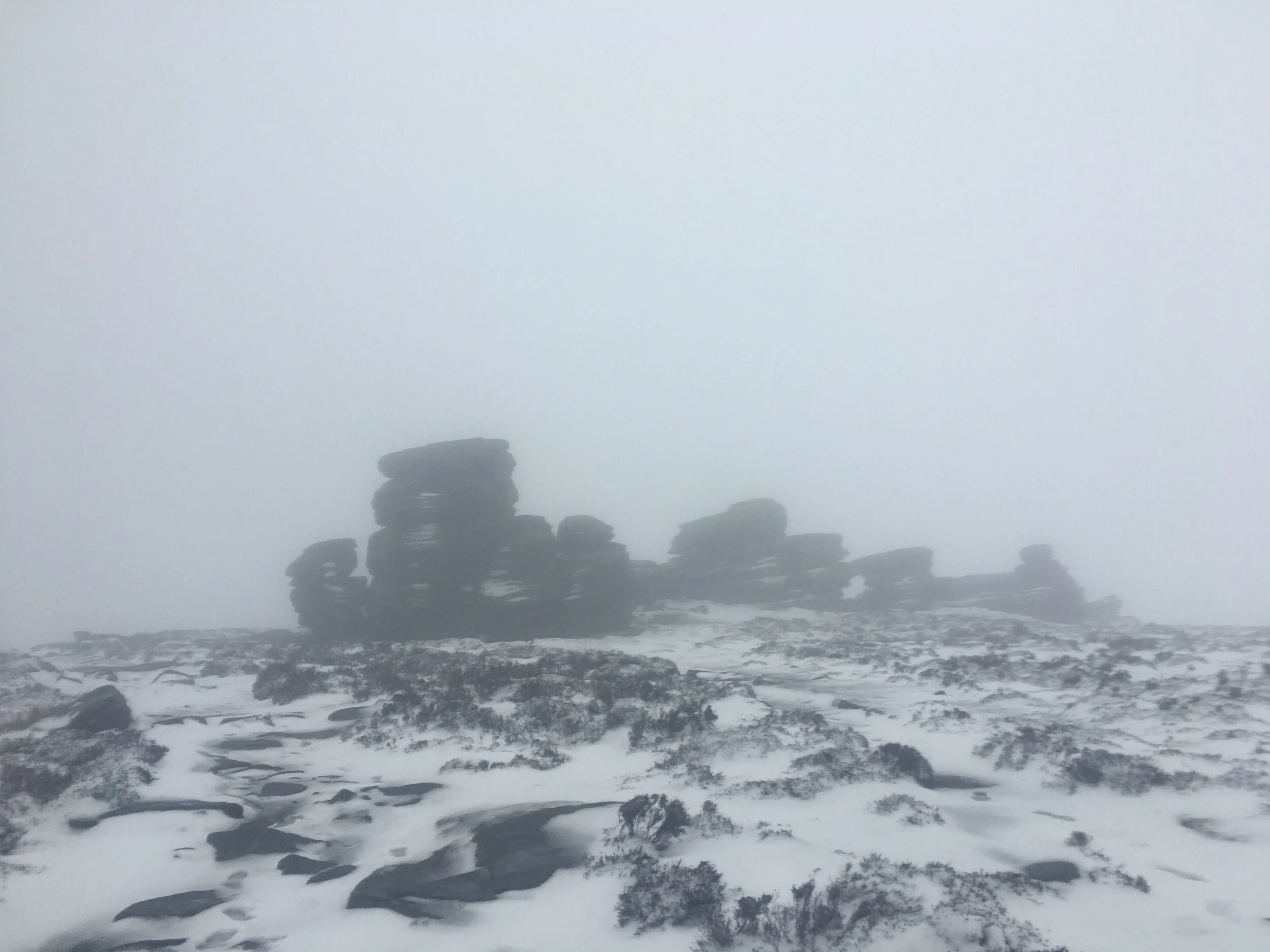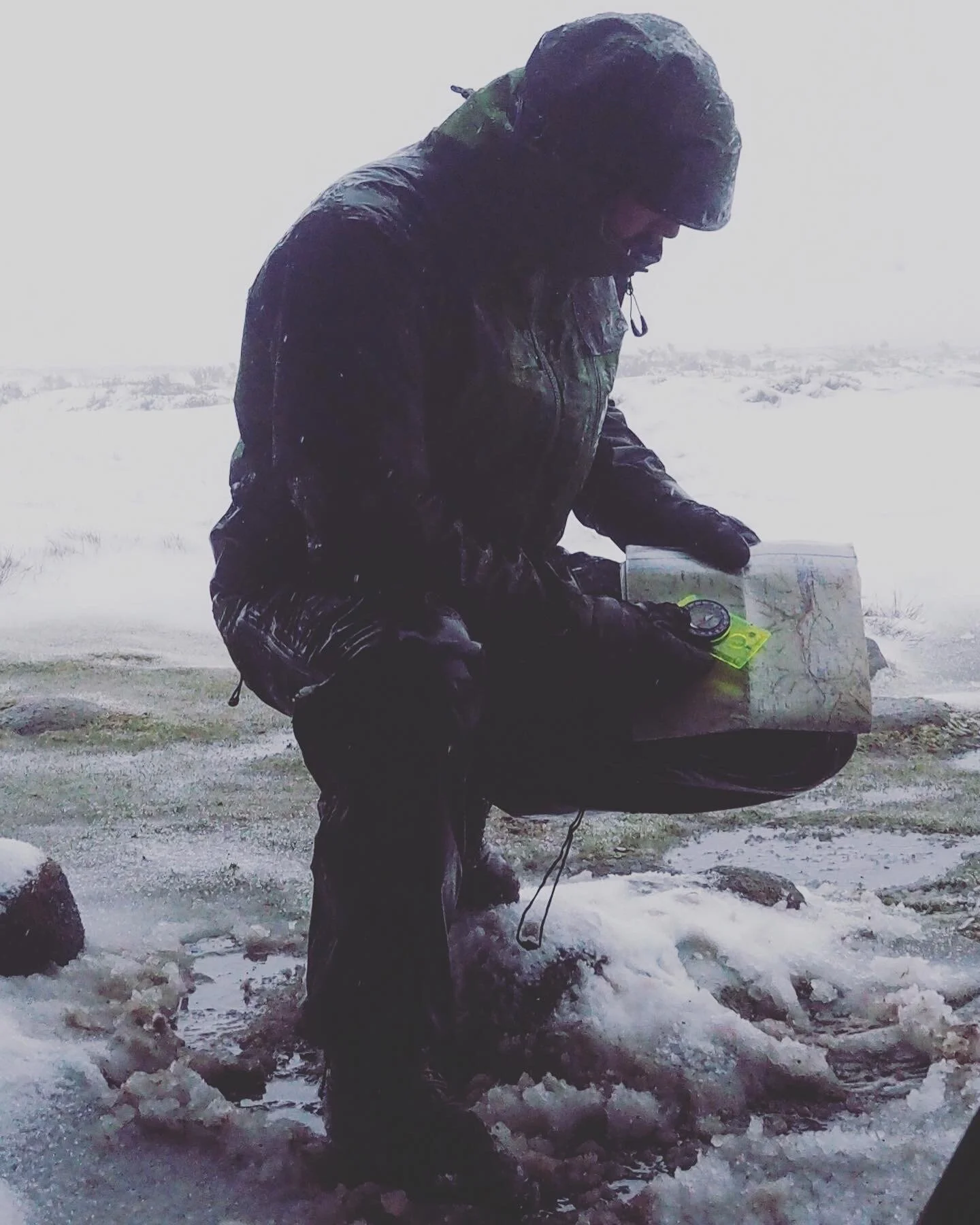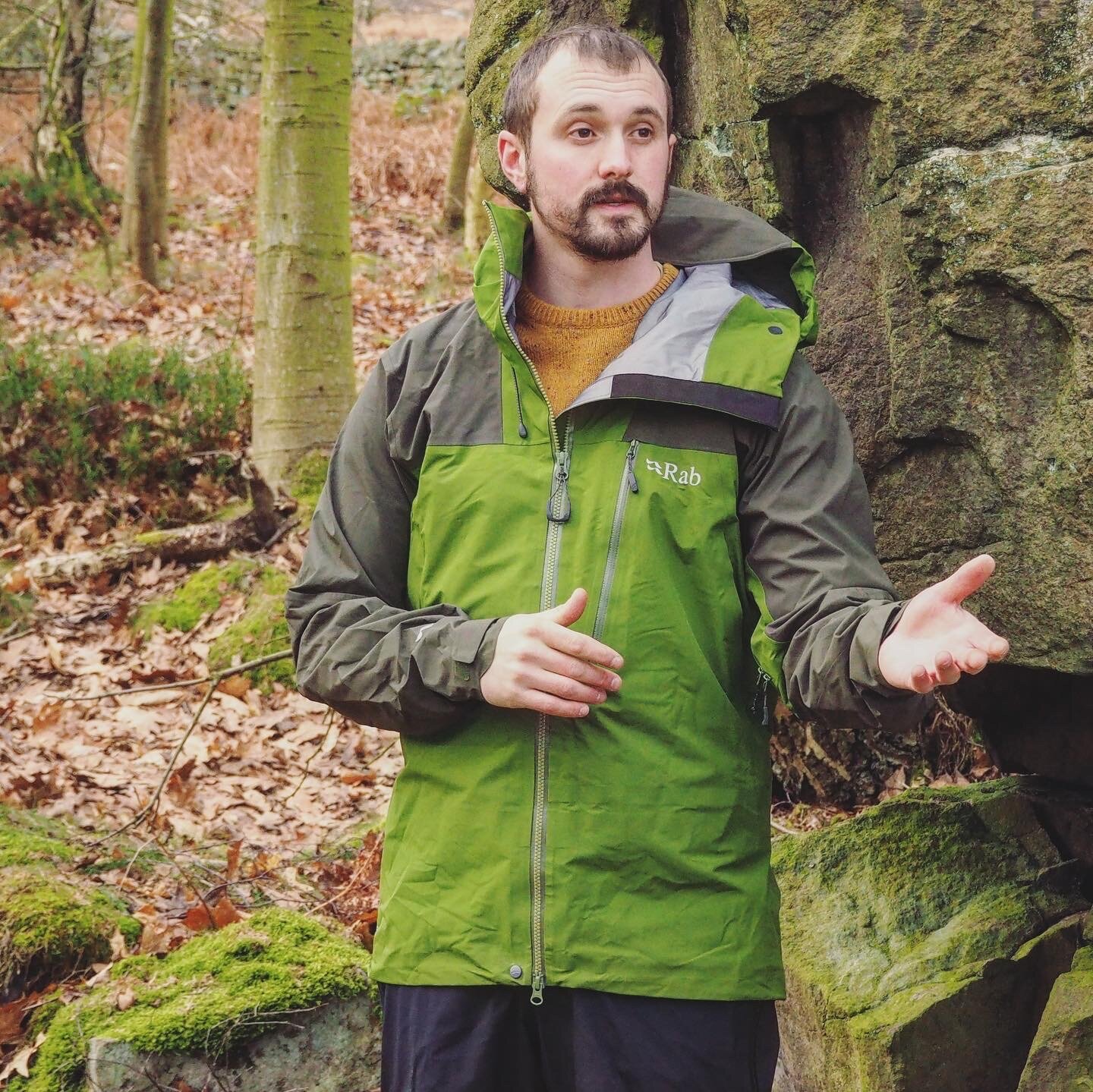Gear Review: Rab Ladakh GTX Jacket
Jamie Dakota
“I’ve been wearing the Ladakh Jacket all winter since early November when Rab sent it to me, during every outing and course, mountain day to school run. I’ve spent 6 hours out during storm Ciara and 4 hours out in storm Dennis to gain a full appreciation of what this jacket is actually like under those circumstances. ”
Having worn it in well past the ‘out of the box’ condition where the DWR coating does most of the work, I’ve worked the Ladakh to the point of failure (or tried to!) and feel confident now in my assessment. Below I’ve cached my review in a trip out onto Bleaklow during a midnight navigation session with the Howl team, that hike encapsulated a good range of what the Ladakh is capable of. (You’ll appreciate the photos have come from across my use of the jacket this winter, as it was pitch black during the actual hike.)
It shows that I’ve been more than happy to throw this jacket on even when it’s not raining, it’s comfortable and well fitting. Other waterproofs I’ve used have stayed in the pack until bitter necessity has made me put them on. With the Ladakh, you can just wear it as easy as you’d chuck on a hoodie, it’s comfy. The paneling of different fabric Rab have used to structure this jacket really plays into this, with a 70D Goretex Pro only where you get the most value from it: across the shoulders and down the arms to fortify the Ladakh against the exposure those areas get. Everywhere else, you get this comfortable C-knit Goretex fabric. A new fabric for me, and at first I didn’t realise it was a laminated waterproof fabric at all, it’s soft and quiet. This combination makes for a breathable, light and flexible jacket which all winter I’ve been only too happy to put on. I’d be interested to see how a jacket made mostly out of that might work for the spring or even summer downpours.
From a lay-by on the Woodhead Pass we took strides into the storm currently lashing the Bleaklow Plateau.
I’ve been humbled to receive the new Ladakh GTX Jacket from Rab to accompany me on my winter hiking trips this past few months. I’d promised to give the new marriage with Gore Tex fabrics a thrashing to see how the different fabrics handled the conditions of a UK winter, so there we were at 9.30pm in early January about to walk into a rain washed heath-land via a tight, rocky stream valley.
At the valley bottom the weather was mild, 8C and lightly raining. I’d layered for the climb up a stream path onto Featherbed Moss, so a merino base layer and a Shadow Hoodie was all I had under the Ladakh. I was also wearing the solid Kangri GTX pants but that’s a review for the future!
Working hard on the ascent I had the underarm vents wide open, with the wind yet to hit us I didn’t need to worry about rain being blown into the vents. This ‘pit-zips’ are critical in controlling your micro-climate within a jacket, and Rab have made them plenty big enough to give you maximum venting on this jacket.
As we began climbing the terrain was very steep at times, with large boulder sections to scramble over where you’re head is cocked back to look up the valley, this is when hood of the jacket really starts working for you.
Rab’s hood designs are known for being simply perfect and with the Ladakh they’ve outdone themselves. In essence there are just two shock-cord adjusters, but it’s the arrangement that I like. The first is a straight-forward halo draw-cord, with a one handed pull toggle at the back. This fits the hood to your head and takes volume out of the top of the hood if you’re not wearing a helmet. The second draw-cord is ingenious, as it incorporates a toggle at the back to again cinch down the volume of the hood if you’re not wearing a helmet and helps to draw in the material to prevent droughts around the back of your neck.
This draw-cord also has a sleek hidden pull toggle at each end on the front of the hood, which draws the collar of the hood closely into your chin. This subtle multi-directional adjustment makes for a versatile defence system against wind and rain in any direction while also maintaining maximum visibility for looking around while climbing.
I’ve certainly never had a hood like it, you’d think it might be complex to use given the 4 pull points but it isn’t. I set the lower pull cord at the back at the start of a hike to take out the volume, then use the halo drawstring and two front pulls to easily adjust the fit to counter wind/ rain etc as I hike. It’s ace.
Ascending out towards the top of the valley we had a bit of scrambling to do, we’d elected to follow the stream closely for a challenging route in the dark, so plenty of reaching for handholds while the rain started to turn sleety. The stream was a torrent, forcing us up onto rocky outcrops and heather-clad slopes in steep falls as the valley narrowed.
The Ladakh specialised cut for climbing really comes out for you during this stuff.
Rab have done three things here which set this jacket up for me in terms of its general tailoring. First, the jacket is long so it covers your backside properly when hiking and if you’re really reaching up the rear hem doesn’t ride up past you waist. Then there’s the shoulders being roomy, which makes for a freedom of movement when active, the last thing you want when clambering up a clough in a rainstorm is pulling against your own jacket to reach a handhold. The wide shoulder across the yoke and volume under the arm is spot on for this movement. Finally, the arms of this jacket is bang on. I really appreciated the length as I’ve used them to completely cover my hands when I forgot gloves, to having the cuffs done up tight around my wrists to free me hands for rope work and the length allows for that perfectly. As they’re articulated too and not just cylinders of fabric you get a high degree of free movement without flapping about like a duffle bag. As we climbed up that valley in the sleet I was grateful that between strapping the cuffs tight to my wrists over my gloves and the length in the arms I was always fully protected from any ingress of water while we scrambled our way to the plateau. The lack of storm flaps, excess material, and the minimalist approach Rab have taken to the overall constructions really works for you here during climbs, you feel streamline and tactical.
As we left the valley and the hill rounded out to the plateau we got blasted by the winds and increasingly heavy sleet becoming snow.
It was flying in from the south and robbing us of any visibility quickly, as a huge wall of low cloud moved across Bleaklow we lost sight of the Emley Moor mast which is the easy option for bearings. So gathered on the lea side of a peat mound we whipped out the maps and compasses and took our bearings as the last of the masts' light disappeared. We wanted to do some micro-navigation on the hill and as we’d been forced to climb out of the valley short of the path with the heavy water flow we needed to locate our exact position on the hill.
With our location marked, and a bearing to walk we continued to trek into what was now weather well beyond the scope of what I’d considered the Ladakh capable of handling. Ordinarily had I known we’d be up in 50mph winds, with a wet snow storm blowing around us sticking melty globs of the white stuff to every exposed part of us I’d have worn the heaviest, thickest jacket I own. So in terms of a test, Bleaklow really brought the fight that night.
A quick mention on the pockets of the Ladakh here. The hand warmer pockets are cavernous but not bulky either (I noticed Rab have achieved this with the envelope construction inside...genius. Very impressed with those, I’d stowed a full OS map in one and gloves in the other without issue.
The outer chest pocket is equally impressive, I’ve had a GPS in there during longer hikes and its spot on. During this hike my compass and mini laminated map section lived in here, my only niggle was I’d like a gear tie in this pocket to lash my compass and mini map to so the wind can’t whip it away should my grip slip.
The hand pockets are great, I know Rab generally has great pocket position to allow for rucksack straps etc and they’ve got it right in the Ladakh too. I did wonder about the storm flaps being open towards the sky rather than hanging open towards the ground for the rain protection, again I’ve been out for hours in the worst rain and not had an issue so it shows what I know!
As I’ve had this jacket all winter I had plenty of time to consider the possibilities. I may leave the zips open by accident (I had done this actually when setting after we’d had the maps etc out during the Bleaklow hike) and in that case the storm flaps could perhaps direct water into the pockets... So at home I poured 800ml of water into each of the hand pockets, did up the zips then took a half hour walk about my neighbourhood….They didn’t let water through the inside to my fleece! So even if I left the zips open by accident on a rainy day, and managed to absolutely fill them with water I know I’d be dry inside. Clearly an unrealistic concern really, but I had a laugh trying it.
Dry cold and snow would be no worry, equally would be torrents of wind, but man that transitional wet snow...that’ll ask for your hypothermic corpse as payment to pass the plateau on nights like that.
Max powering on through the snow (The only photo I actually managed during the hike).
Heading south into the headwind I made full use of the hood system with what I’ve been calling the Knight’s Visor effect. Just dipping your head down 45 degrees and the peak of the hood drives the wind and snow down over the collar and completely blocks the weather from getting to your face. It’s superb, look up to get an overview of the land but then dip your head to cut out the weather and crack on with a window of about 8 metres in front of you. The peak of the hood plays a part here too, no need of a wire like many hoods (I’ve had them snap and be generally crap to mold etc. always look bumpy) This clean stiff construction here is all you need, and just to say whoever put the felt inside the chin of the jacket...well done! It’s those features that make all the difference.
For more than an hour we moved through the snow, stopping often to hit stones we were navigating to, or stream junctions, ring contours and the like.
It started to get truly testing as we made our way towards the route out from the hills, aiming for a fractal branching of streams pouring into the Far Black Clough trail down from the plateau.
I’d swapped to the Blizzard Mitts during one of our stops and it was the first time this winter I’d really needed that level of insulation. The mitts are solid, waterproof, with excellent closures for wearing over a jacket in frozen conditions, but with the melting snow I wanted to pull the jacket cuffs over the top of them to stop water running down into them. The ladakh allows for this with ease, having nicely wide cuffs to pull over the mitts. Great in simplicity, don’t need to be anything more complicated than a velcro strap closure. The cuffs are subtly cut with extra length on the outside, I’ve taken to only half tightening the cuff velrco most days as the long arm length combined with the cut of the cuff means I essentially create a gauntlet covering my hands down to the knuckles while still having my palm free to hold poles or climb.
We were still working hard, moving fast and light across the snow blanketed peat moor. And through the cloud we find our way to the main track, having jumped many a stream and climbed up over a few peat sided cloughs.
Descending steadily we noted the time at 2am, we’d been walking for 5 hours so far.
As the track is easier to walk, and the energy levels relax a bit we started to cool off. So far I’ve kept just the merino layer and softshell under the Ladakh, but I needed another layer now so I stopped and pulled out the Electron jacket to put under the hardshell of the Ladakh. We’d dropped off the hill by around 100m metres by then too, so the snow had eased and we were in light rain now.
The cut of the Ladakh easily allows for a down jacket underneath to loft, as Rab designed the Jacket to function as a part of a versatile layering system. The kidney drawcord at the back can be fully released and the volume of the Ladakh widened to accept the insulative layer. It was in doing this that I noticed I had gotten a little inside the Ladakh during the exercises on the hilltop.
I was dubious about the zips I will admit, I’ve always relied on storm flaps to protect from water ingress on the main zip of a jacket. I must concede though, I’ve been highly impressed by the YKK aqua guard zip on the main front zipper. Having spent 5 hours in heavy, melty snow fall I’d say the persistent presence of melting snow stuck to the front of me while hiking did allow some osmosis action through to my softshell underneath. It may even be that water got through the C-knit fabric itself at the stitching to the zips.
I also got slightly damp again around the belly button area during a three hour hike in Storm Dennis a month later, I wasn’t wearing a waist-strap on the rucksack so I can only assume the excessive amount of rain either got through the zip or the seam where the zip a sewn to the C-knit fabric.
Given that this jacket is a lightweight breathable jacket for high levels of exertion, rather than a bomber like the Latok, you would expect some pay off with ultimate waterproofing. And I have indeed found I love this jacket for it’s comfort and range of function over a full 70D GT pro for regular use. If I was working for a wet and wild scottish season on the heath where I was perhap less mobile and just generally hiking, a heavier, thicker jacket may make sense. But for what I do this Ladakh is the clear preference.
In the absolute worst conditions this jacket completely out performed by expectations for such a light layer, and even in the most excessive conditions where maybe a Latok or Kangri might make more sense...the pace and activities we were performing would more than likely have us soaked from sweat under a thicker fabric anyway. I’d always choose light, breathable,and comfort over ultimate waterproofing any day.
The hem is great, the taped construction creates a nice flat structure to allow clean run off.
The stitchless hem and cuffs are brilliant, I didn’t notice them until I watched a YouTube review, but I think that’s about the best compliment you can give such a detail...They work, so you don’t need to even notice the clever design.
The taping on the seams is gorgeous in itself, it’s a shame it's hidden inside the jacket! Those disc patches on the corners are well worth it, and seem to be doing their job perfectly thus far.
That button at the base of the main zip is a master stroke, open the zips with the button snapped allows me to ventilate to the max without the jacket flapping around.
As we returned to the cars at 2.45am we’re worn, laughing with fatigue, and ready for bed.
But I’m 95% dry, warm and satisfied that throughout the hike I’d not had to consider my protection for the elements, and could focus on being efficient with my navigation. This highest compliment I can think of for clothing is that you simply don’t need to think about it when you’re out.
Thanks to the awesome team at Rab for the Ladakh, and for the continued dedication to crafting well thought out clothing to facilitate adventures in the outdoors.















